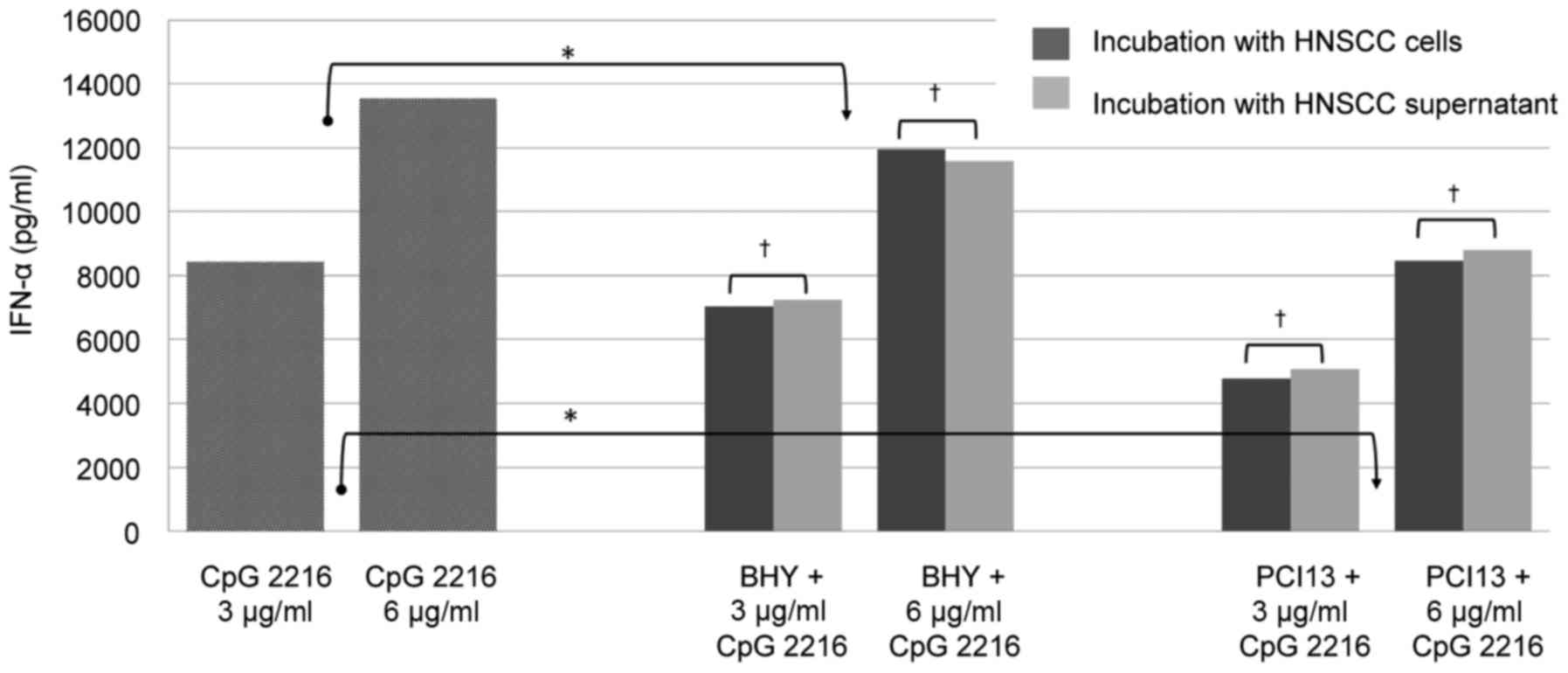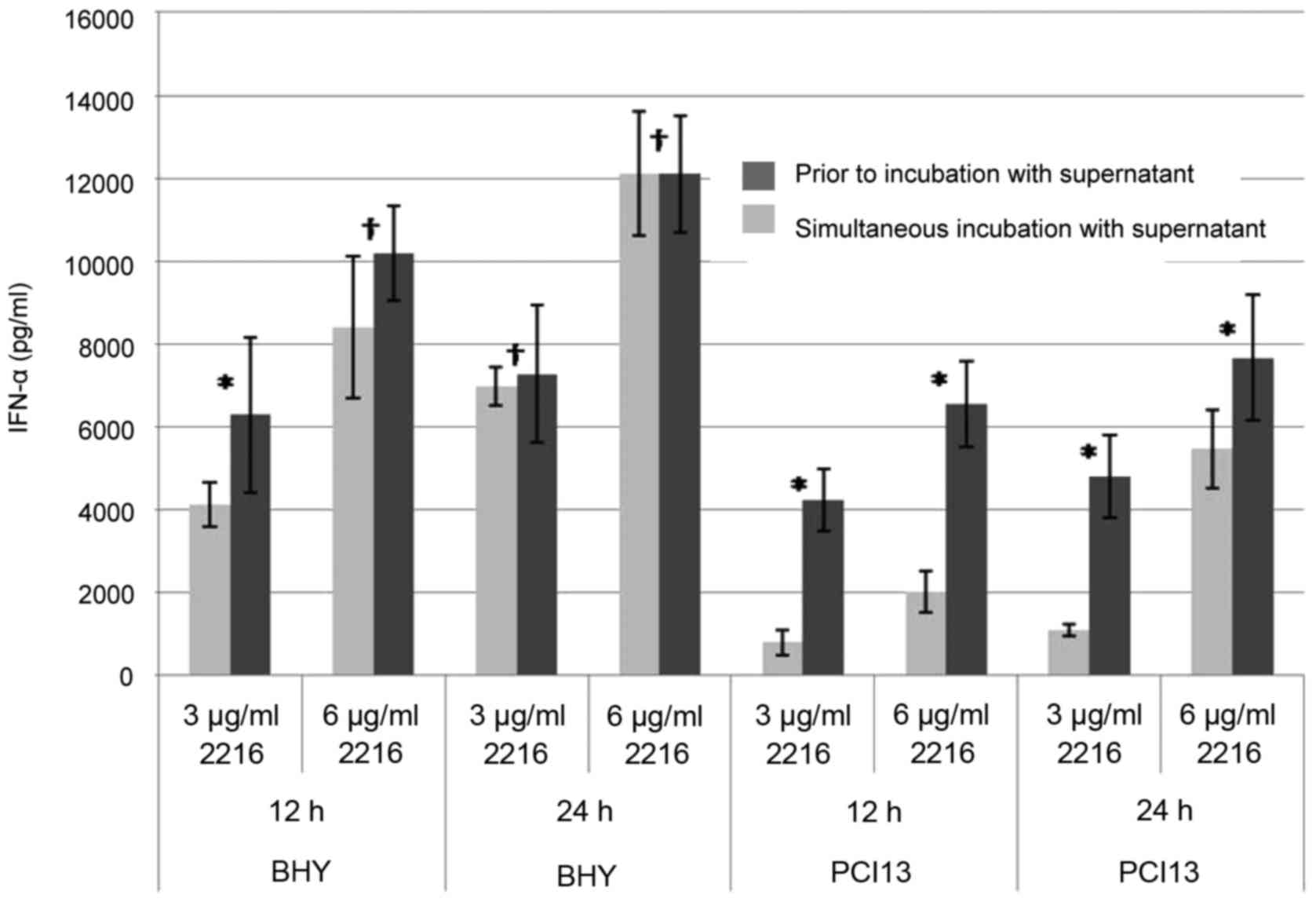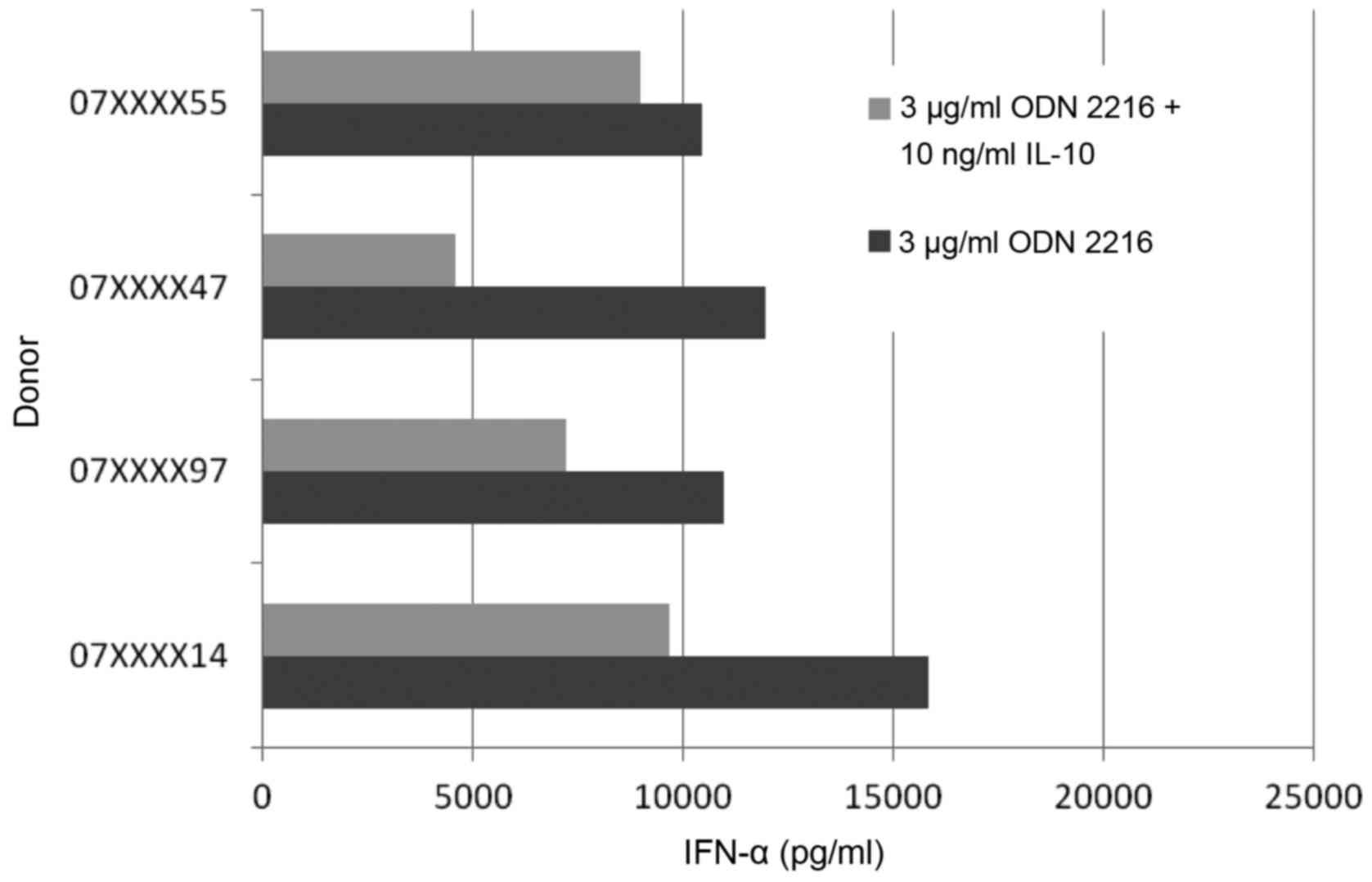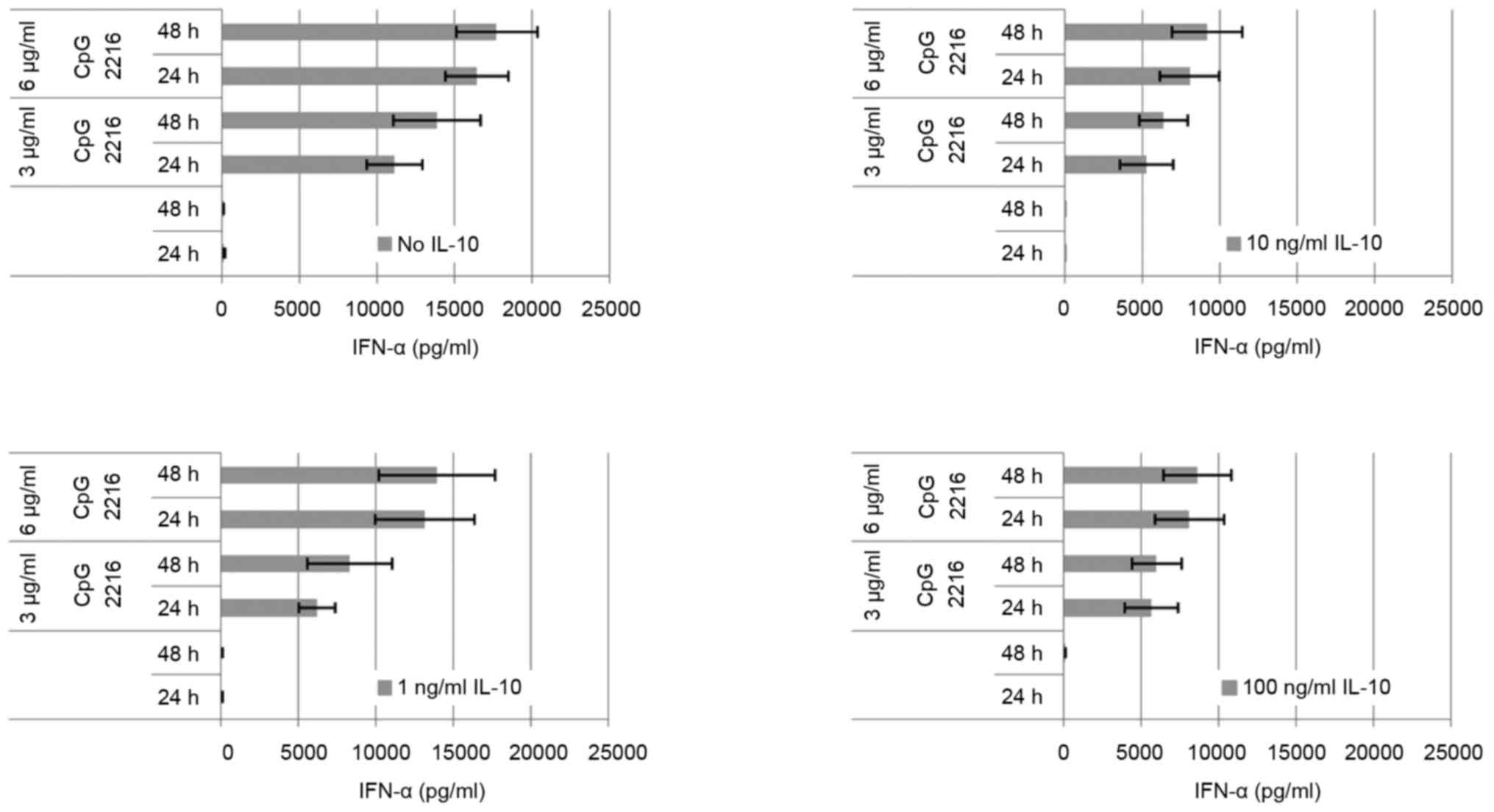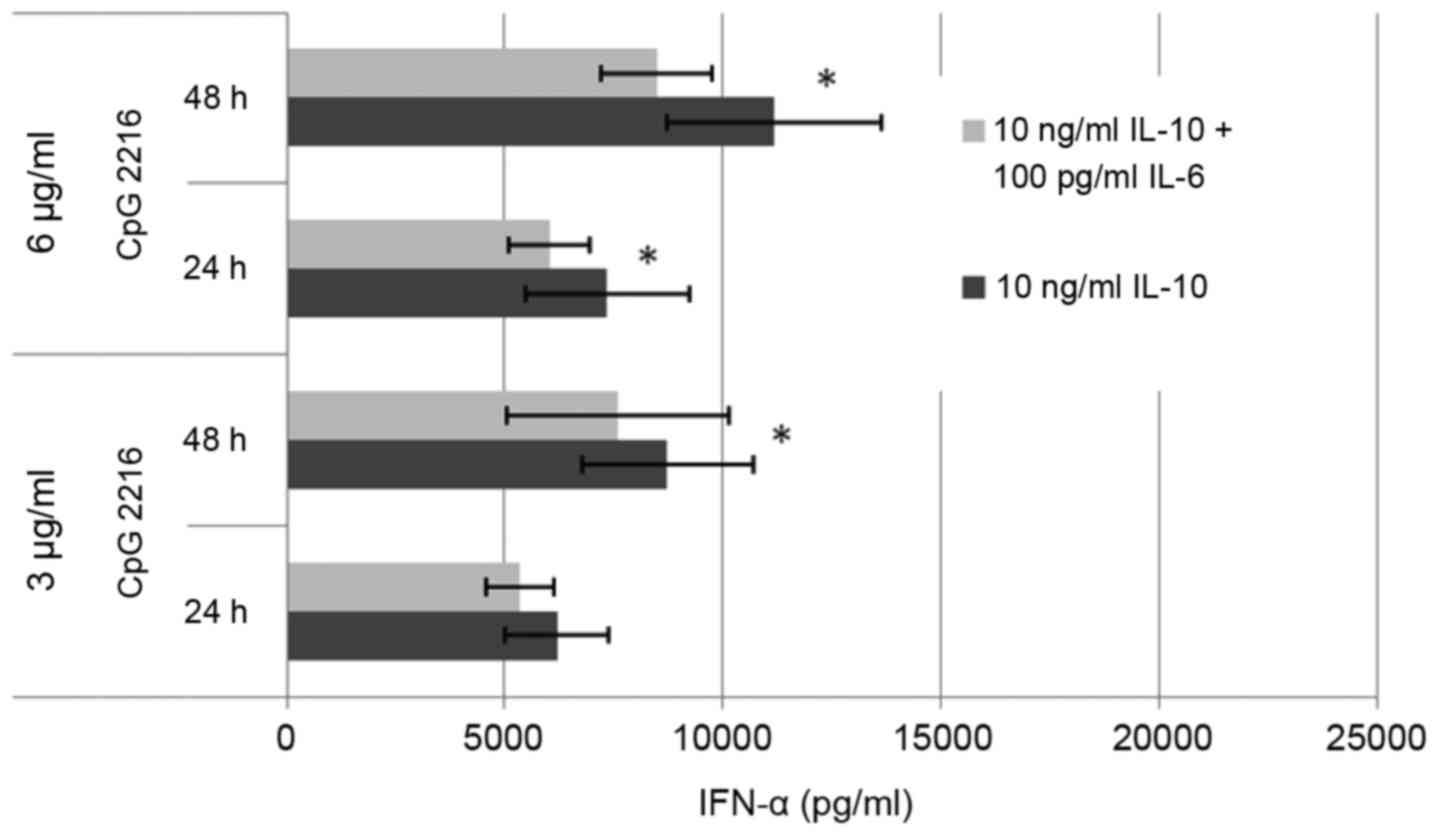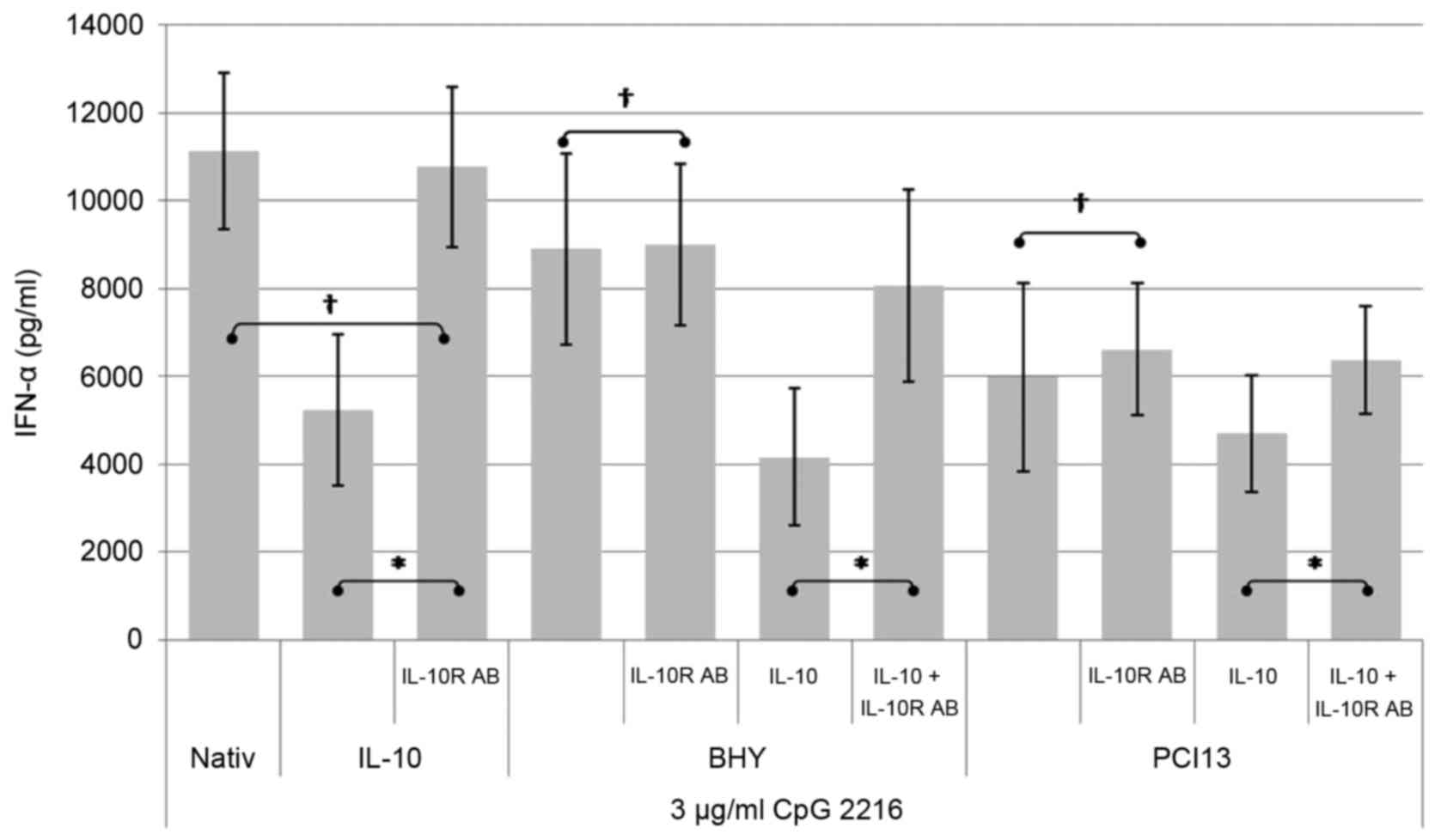|
1
|
Liu Z, Yang L, Cui Y, Wang X, Guo C, Huang
Z, Kan Q, Liu Z and Liu Y: Il-21 enhances NK cell activation and
cytolytic activity and induces Th17 cell differentiation in
inflammatory bowel disease. Inflamm Bowel Dis. 15:1133–1144. 2009.
View Article : Google Scholar : PubMed/NCBI
|
|
2
|
Hartmann E, Wollenberg B, Rothenfusser S,
Wagner M, Wellisch D, Mack B, Giese T, Gires O, Endres S and
Hartmann G: Identification and functional analysis of
tumor-infiltrating plasmacytoid dendritic cells in head and neck
cancer. Cancer Res. 63:6478–6487. 2003.PubMed/NCBI
|
|
3
|
Reichert TE, Rabinowich H, Johnson JT and
Whiteside TL: Mechanisms responsible for signaling and functional
defects. J Immunother. 21:295–306. 1998. View Article : Google Scholar : PubMed/NCBI
|
|
4
|
Steinman RM: The dendritic cell system and
its role in immunogenicity. Annu Rev Immunol. 9:271–296. 1991.
View Article : Google Scholar : PubMed/NCBI
|
|
5
|
Hart DN: Dendritic cells: Unique leukocyte
populations which control the primary immune response. Blood.
90:3245–3287. 1997.PubMed/NCBI
|
|
6
|
Cella M, Sallusto F and Lanzavecchia A:
Origin, maturation and antigen presenting function of dendritic
cells. Curr Opin Immunol. 9:10–16. 1997. View Article : Google Scholar : PubMed/NCBI
|
|
7
|
Müller-Hermelink HK, Stein H, Steinmann G
and Lennert K: Malignant lymphoma of plasmacytoid T-cells.
Morphologic and immunologic studies characterizing a special type
of T-cell. Am J Surg Pathol. 7:849–862. 1983. View Article : Google Scholar : PubMed/NCBI
|
|
8
|
Vollenweider R and Lennert K: Plasmacytoid
T-cell clusters in non-specific lymphadenitis. Virchows Arch B Cell
Pathol Incl Mol Pathol. 44:1–14. 1983. View Article : Google Scholar : PubMed/NCBI
|
|
9
|
Galy A, Christopherson I, Ferlazzo G, Liu
G, Spits H and Georgopoulos K: Distinct signals control the
hematopoiesis of lymphoid-related dendritic cells. Blood.
95:128–137. 2000.PubMed/NCBI
|
|
10
|
Kirkwood J: Cancer immunotherapy: The
interferon-alpha experience. Semin Oncol. 29 3 Suppl 7:S18–S26.
2002. View Article : Google Scholar
|
|
11
|
Krug A, Rothenfusser S, Hornung V,
Jahrsdörfer B, Blackwell S, Ballas ZK, Endres S, Krieg AM and
Hartmann G: Identification of CpG oligonucleotide sequences with
high induction of IFN-alpha/beta in plasmacytoid dendritic cells.
Eur J Immunol. 31:2154–2163. 2001. View Article : Google Scholar : PubMed/NCBI
|
|
12
|
Bauer S and Wagner H: Bacterial CpG-DNA
licenses TLR9. Curr Top Microbiol Immunol. 270:145–154.
2002.PubMed/NCBI
|
|
13
|
Hemmi H, Takeuchi O, Kawai T, Kaisho T,
Sato S, Sanjo H, Matsumoto M, Hoshino K, Wagner H, Takeda K and
Akira S: A Toll-like receptor recognizes bacterial DNA. Nature.
408:740–745. 2000. View
Article : Google Scholar : PubMed/NCBI
|
|
14
|
Krieg AM, Yi AK, Matson S, Waldschmidt TJ,
Bishop GA, Teasdale R, Koretzky GA and Klinman DM: CpG motifs in
bacterial DNA trigger direct B-cell activation. Nature.
374:546–549. 1995. View
Article : Google Scholar : PubMed/NCBI
|
|
15
|
Chin D, Boyle GM, Theile DR, Parsons PG
and Coman WB: Molecular introduction to head and neck cancer
(HNSCC) carcinogenesis. Br J Plast Surg. 57:595–602. 2004.
View Article : Google Scholar : PubMed/NCBI
|
|
16
|
Whiteside TL: Immune suppression in
cancer: Effects on immune cells, mechanisms and future therapeutic
intervention. Semin Cancer Biol. 16:3–15. 2006. View Article : Google Scholar : PubMed/NCBI
|
|
17
|
Pries R and Wollenberg B: Cytokines in
head and neck cancer. Cytokine Growth Factor Rev. 17:141–146. 2006.
View Article : Google Scholar : PubMed/NCBI
|
|
18
|
Mann EA, Spiro JD, Chen LL and Kreutzer
DL: Cytokine expression by head and neck squamous cell carcinomas.
Am J Surg. 164:567–573. 1992. View Article : Google Scholar : PubMed/NCBI
|
|
19
|
Chen Z, Malhotra PS, Thomas GR, Ondrey FG,
Duffey DC, Smith CW, Enamorado I, Yeh NT, Kroog GS, Rudy S, et al:
Expression of proinflammatory and proangiogenic cytokines in
patients with head and neck cancer. Clin Cancer Res. 5:1369–1379.
1999.PubMed/NCBI
|
|
20
|
Liu YJ: IPC: Professional type 1
interferon-producing cells and plasmacytoid dendritic cell
precursors. Annu Rev Immunol. 23:275–306. 2005. View Article : Google Scholar : PubMed/NCBI
|
|
21
|
Cella MF, Facchetti F, Lanzavecchia A and
Colonna M: Plasmacytoid dendritic cells activated by influenza
virus and CD40L drive a potent TH1 polarization. Nat Immunol.
1:305–310. 2000. View
Article : Google Scholar : PubMed/NCBI
|
|
22
|
Rissoan MC, Soumelis V, Kadowaki N,
Grouard G, Briere F, de Waal Malefyt R and Liu YJ: Reciprocal
control of T helper cell and dendritic cell differentiation.
Science. 283:1183–1186. 1999. View Article : Google Scholar : PubMed/NCBI
|
|
23
|
Kawamata H, Nakashiro K, Uchida D, Harada
K, Yoshida H and Sato M: Possible contribution of active MMP2 to
lymph-node metastasis and secreted cathepsin L to bone invasion of
newly established human oral-squamous-cancer cell lines. Int J
Cancer. 70:120–127. 1997. View Article : Google Scholar : PubMed/NCBI
|
|
24
|
Beckebaum S, Zhang X, Chen X, Yu Z,
Frilling A, Dworacki G, Grosse-Wilde H, Broelsch CE, Gerken G and
Cicinnati VR: Increased levels of interleukin-10 in serum from
patients with hepatocellular carcinoma correlate with profound
numerical deficiencies and immature phenotype of circulating
dendritic cell subsets. Clin Cancer Res. 10:7260–7269. 2004.
View Article : Google Scholar : PubMed/NCBI
|
|
25
|
Duramad O, Fearon KL, Chan JH, Kanzler H,
Marshall JD, Coffman RL and Barrat FJ: IL-10 regulates plasmacytoid
dendritic cell response to CpG-containing immunostimulatory
sequences. Blood. 102:4487–4492. 2003. View Article : Google Scholar : PubMed/NCBI
|
|
26
|
Pries R, Thiel A, Brocks C and Wollenberg
B: Secretion of tumor-promoting and immune suppressive cytokines by
cell lines of head and neck squamous cell carcinoma. In Vivo.
20:45–48. 2006.PubMed/NCBI
|
|
27
|
Strauss L, Volland D, Kunkel M and
Reichert TE: Dual role of VEGF family members in the pathogenesis
of head and neck cancer (HNSCC): Possible link between angiogenesis
and immune tolerance. Med Sci Monit. 11:BR280–BR292.
2005.PubMed/NCBI
|
|
28
|
Thomas GR, Chen Z, Leukinova E, Van Waes C
and Wen J: Cytokines IL-1 alpha, IL-6, and GM-CSF constitutively
secreted by oral squamous carcinoma induce down-regulation of CD80
costimulatory molecule expression: Restoration by interferon gamma.
Cancer Immunol Immunother. 53:33–40. 2004. View Article : Google Scholar : PubMed/NCBI
|
|
29
|
Riedel F, Zaiss I, Herzog D, Götte K, Naim
R and Hörmann K: Serum levels of interleukin-6 in patients with
primary head and neck squamous cell carcinoma. Anticancer Res.
25:2761–2765. 2005.PubMed/NCBI
|
|
30
|
Duffy SA, Taylor JM, Terrell JE, Islam M,
Li Y, Fowler KE, Wolf GT and Teknos TN: Interleukin-6 predicts
recurrence and survival among head and neck cancer patients.
Cancer. 113:750–757. 2008. View Article : Google Scholar : PubMed/NCBI
|
|
31
|
Bollrath J, Phesse TJ, von Burstin VA,
Putoczki T, Bennecke M, Bateman T, Nebelsiek T, Lundgren-May T,
Canli O, Schwitalla S, et al: gp130-mediated Stat3 activation in
enterocytes regulates cell survival and cell-cycle progression
during colitis-associated tumorigenesis. Cancer Cell. 15:91–102.
2009. View Article : Google Scholar : PubMed/NCBI
|



